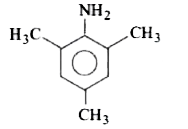The reaction in terms of intermediates and type of reaction is given below. Mark the incorrect option.
Carbocation intermediate
Free radical intermediate


The correct Answer is:C
To solve the question regarding the reaction intermediates and types of reactions, we will analyze each option provided and identify the incorrect one.
1. Option 1: CH3-CH=CH2 + HBr
- This reaction involves the addition of HBr to an alkene (propene).
- According to Markovnikov's rule, the hydrogen (H) will add to the carbon with more hydrogen substituents, forming a more stable carbocation.
- The intermediate formed is a carbocation (specifically a tertiary carbocation), which is correct.
- Conclusion: This option is correct.
2. Option 2: CH3-CH=CH2 + HBr (in the presence of peroxide)
- In the presence of peroxides, the reaction follows the anti-Markovnikov rule.
- The HBr dissociates into H• and Br• free radicals.
- The free radical mechanism leads to the formation of a free radical intermediate, which is also correct.
- Conclusion: This option is correct.
3. Option 3: C=C + X2
- This reaction represents the addition of a dihalogen (X2) to an alkene.
- The reaction is a simple addition reaction where each halogen atom (X) adds to the double bond, resulting in a vicinal dihalide.
- However, the statement refers to it as an "electrophilic substitution reaction," which is incorrect. This reaction is not a substitution but rather an addition reaction.
- Conclusion: This option is incorrect.
4. Option 4: C=C + O3
- This reaction involves the addition of ozone (O3) to an alkene.
- The product formed is an ozonide, which can further decompose to yield aldehydes or ketones.
- This process is correctly described as ozonolysis.
- Conclusion: This option is correct.
Final Answer:
The incorrect option is Option 3: C=C + X2 is incorrectly labeled as an electrophilic substitution reaction.
- This reaction involves the addition of HBr to an alkene (propene).
- According to Markovnikov's rule, the hydrogen (H) will add to the carbon with more hydrogen substituents, forming a more stable carbocation.
- The intermediate formed is a carbocation (specifically a tertiary carbocation), which is correct.
- Conclusion: This option is correct.
- In the presence of peroxides, the reaction follows the anti-Markovnikov rule.
- The HBr dissociates into H• and Br• free radicals.
- The free radical mechanism leads to the formation of a free radical intermediate, which is also correct.
- Conclusion: This option is correct.
- This reaction represents the addition of a dihalogen (X2) to an alkene.
- The reaction is a simple addition reaction where each halogen atom (X) adds to the double bond, resulting in a vicinal dihalide.
- However, the statement refers to it as an "electrophilic substitution reaction," which is incorrect. This reaction is not a substitution but rather an addition reaction.
- Conclusion: This option is incorrect.
- This reaction involves the addition of ozone (O3) to an alkene.
- The product formed is an ozonide, which can further decompose to yield aldehydes or ketones.
- This process is correctly described as ozonolysis.
- Conclusion: This option is correct.
The incorrect option is Option 3: C=C + X2 is incorrectly labeled as an electrophilic substitution reaction.
Topper's Solved these Questions
- HYDROCARBONS BOOK - NCERT FINGERTPS ENGLISHCHAPTER - HYDROCARBONS EXERCISE - Higher Order Thinkin Skills
7 Videos
- HYDROCARBONS BOOK - NCERT FINGERTPS ENGLISHCHAPTER - HYDROCARBONS EXERCISE - Assertion & Reason
15 Videos
- EQUILIBRIUM BOOK - NCERT FINGERTPS ENGLISHCHAPTER - EQUILIBRIUM EXERCISE - Assertion And Reason
15 Videos
- HYDROGEN BOOK - NCERT FINGERTPS ENGLISHCHAPTER - HYDROGEN EXERCISE - Assertion And Reason
15 Videos
Similar Questions
Knowledge Check
Animal classification is depicted below. Mark the correct option.
 AA-Limbs
AA-Limbs
B-Egg with amnion membrane
C-Milk, hair
D-FeathersBA-Egg with amnion membrane
B-Limbs
C-Milk, hair
D-FeathersCA-Swin bladder
B-Limbs
C-Milk,hair
D-FeathersDA-Milk, hair
B-Limbs
C-Egg with amnion membrane
D-FeathersThe hybridisation state of the central atom and shape of the molecules is given below. Mark the incorrect combination.
ASO3−sp2 hybridisation, planar triangularBSO2−sp2 hybridisation, V-shapedCH2SO4−sp2 hybridisation, V-shapedDO3−sp2 hybridisation, angularIdentify 'Z' in the reaction given below :
 A
A B
B C
C D
D





_CHE_E06_275.png) The intermediate formed in the above reaction is a
The intermediate formed in the above reaction is a